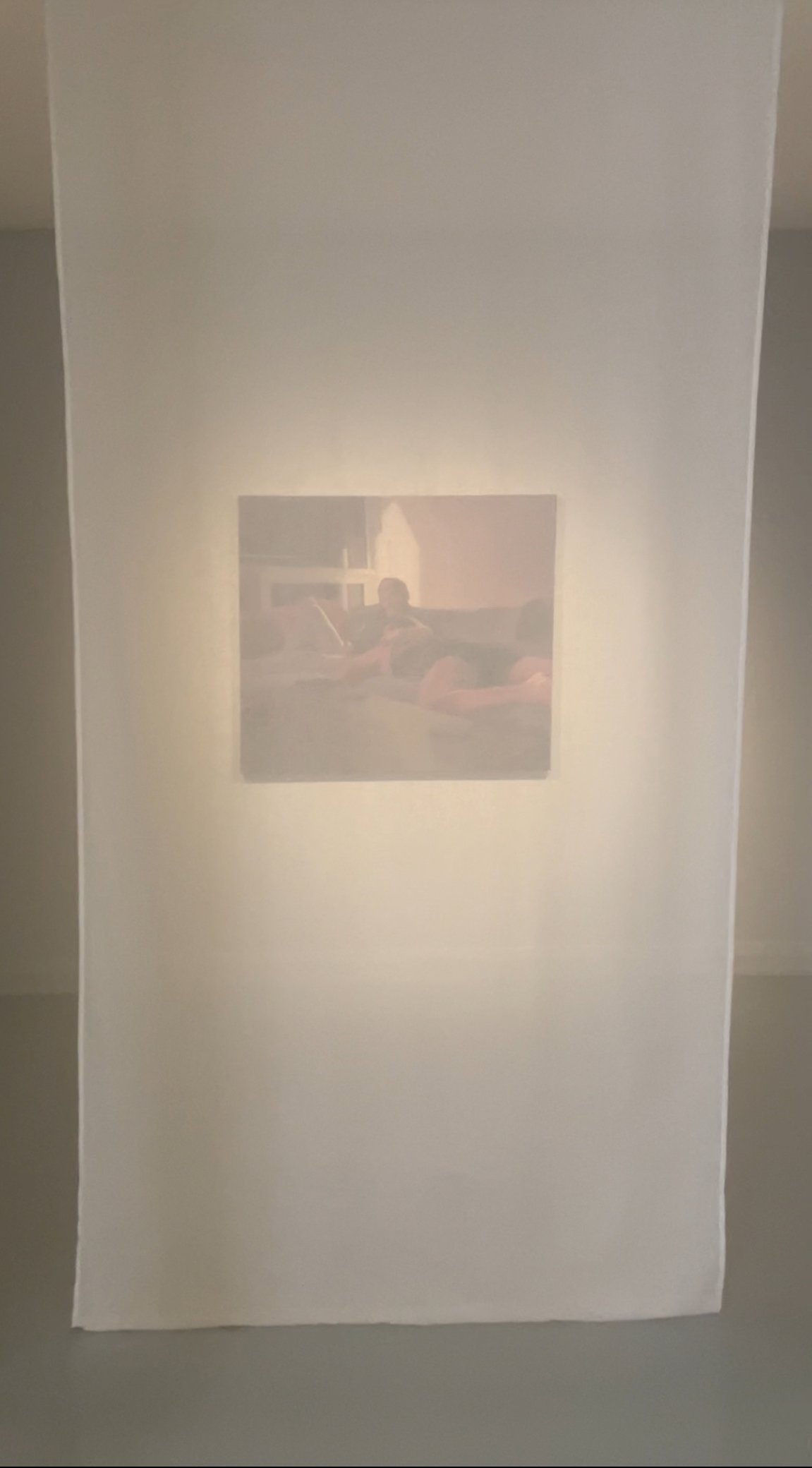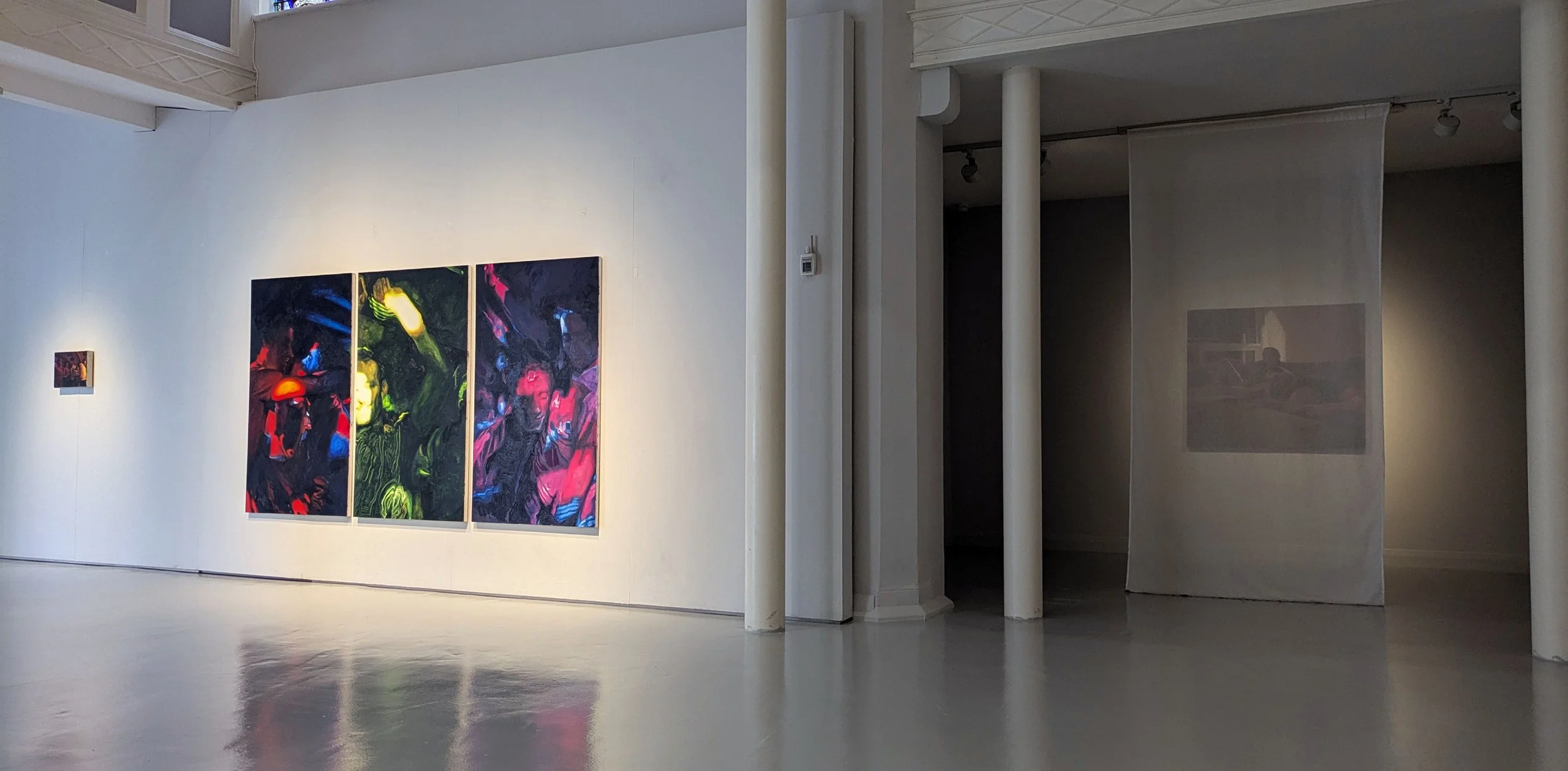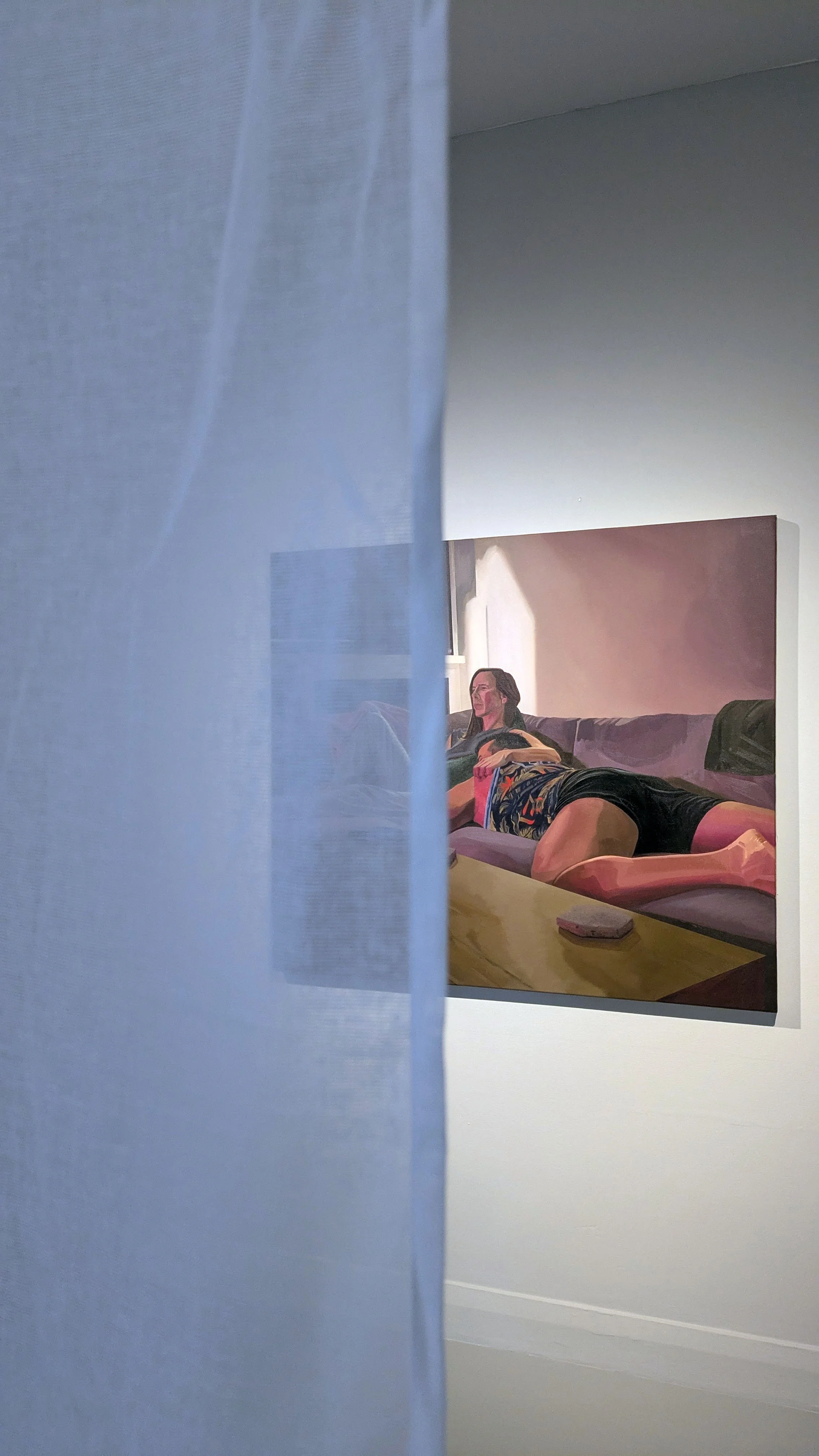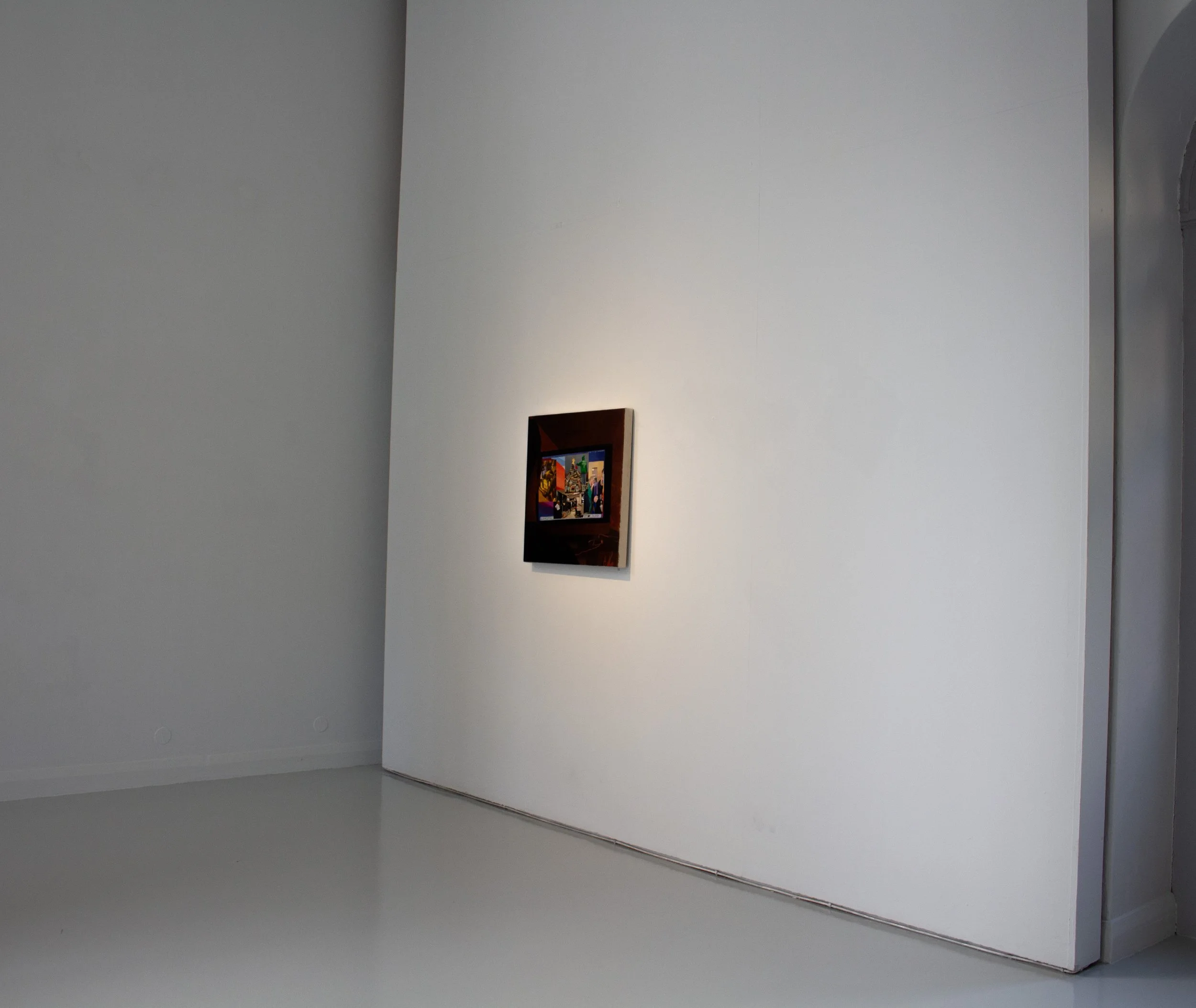Dysphoric Euphoria
Dysphoric Euphoria presents polarising extremes of queer existence. Within this exhibition Peter Bradley and Stephen Doyle explore the joys and the hardships of Queer experiences through painting. Taking on themes of societal exclusion, religious power, and identity in a contemporary Irish society.
The titular duality is divided by the artists. Doyle manifests Dysphoria by allowing discomfort to become tangible through their handling of paint and installation work. They depict some of the major obstacles facing the community to challenge systems of power and oppression in its various forms. Bradley’s collection portrays the Euphoric through themes of community, joy as a form of resistance, and liberation from gender norms through playful collages of paint, plexiglass and personality.
Accompanying the paintings within the show are texts by El Reid- Buckley, FELISPEAKS and William Keohane.
Title: Anathema
Medium: Oil on Canvas
Dimensions: 140x160cm
The catholic organisation has contributed to shaping Irish identity for better and certainly for worse. Its influence has been deeply damaging, particularly in terms of its role in suppressing social progress, enabling abuse, and fostering a climate of shame and exclusion. The legacy of these harms is still being felt today especially for women and the queer community.
When the Christian’s adopted the usage of the word ‘anathema’ from the greeks in the 1st to 4th century, they shifted its meaning from ‘thing dedicated’ or ‘offering’ to ‘curse’ or ‘condemnation’ especially in relation to heretics (those who shifted from the Christian faith). Its usage progressed through medieval christianity and it shifted ever so slightly to refer to excommunication, those who were formally cast out of the church or declared cursed. In modern day usage it is typically used to refer to something that is strongly opposed or completely rejected by an individual or group. Within this painting, this etymology is explored via its relationship to the Irish State, specifically those most likely to be associated with its meaning.
A found sculpture of Jesus Christ towers over and casts a harsh shadow over the urban Irish landscape. The head of this sculpture appears to have been lost in time, however Doyle has created a replacement. A head that has been manipulated and morphed by human hands into something so foreign from its origins. Drawing parallels to how fundamental Christians have manipulated the image of Christ to reinforce their bigotry towards minority groups. The head faces away from a mirror that hangs directly behind this rendering of Christ, which in the context of painting has always referred to self-reflection. Nodding to the organisation's reluctance to do so. By refusing to acknowledge the damages done to the community (both Irish and queer) and offering real, substantial compensation and commitment to change, the wounds caused can never fully heal and the pain of which is kept in perpetual existence.
Title: Bent Bastards
Medium: Oil on Canvas with Hanging Text on Canvas
Dimensions: 180X120cm (Without hanging text installation element).
This piece is a collaborative work between spoken word artist/ performer/ poet FELISPEAKS and visual artist Stephen Doyle. The work was inspired by Dr. Emma Dabiri’s ‘What White People Can Do Next’. In which she discusses the requirement of coalition within society for substantial and effective positive change. This work was equally conceptualised and created by both artists, in the attempt to create an artwork that truly reflected the two artists' practices yet also something neither would have created independently.
Dabiri quotes ‘A Rap on Race’, a conversation between James Baldwin and Margaret Mead in her book, “Instead of focusing on structural change, change occurs on the level of vocabulary”. Here FELISPEAKS and Doyle entangle the Irish landscape with their text, centring the image of what being Irish and Queer can look like. Restructuring the space so it can include further possibilities.
The vocabulary extends out into the space haunting the painting out of fashion. The viewer has to look up to read it, contort themselves to read and therefore understand. That's how queerness feels in a hetero-world, needing to contort. Creating a subtle discomfort.
The work is about finding sameness in each other in a world hell bent on pointing out our differences. We are indeed different, different shades, different tones to our voices, and different parts of the country have shaped us. Indeed, we have a contrast between us because our containers are worlds apart. Yet, like all queers, all bent bastards, we live on the fringes of the containers that house us. We know what it is to be ribboned, pulled into pieces in our own communities. There, at that ribboned end, we meet. We not only meet, we know each other, we speak the same language and we hum in agreement.
The collaboration is significant because Fringe-ness beckons you to find more people that are you, but not. Our work is centred and continues to be centred on comforting the disturbed. We, the disturbed, find comfort in each other.
Title: A Relentlessness
Medium: Oil on Canvas
Dimensions: 60X60cm
To be queer, is to be political, there is no choice but to take up the activist lifestyle in one form or another. LGBTQIA+ rights are fought for and it takes generations of fighters for people to see us as equal. Recently there has been a global rise in the far-right, campaigning for the removal of these rights. ‘A Relentlessness’ embodies the sensation of fear through its use of colour. The variety of colour on the screen allows the viewer to focus on the social media content while the atmosphere in the room which the figure inhabits is compressed by a monotonal orange hue. Causing the space to seem flattened and tightened. Implying this moment of bombardment by violent and fascist imagery unfolding on the monitor is so significantly psychologically gripping the figure it can be physically felt too.
Doyle has selected a group of images made public on social media over the last few years that follow troubling and repetitive trends. Going from right to left; these images include references to the drag story time at the Tralee Library which was stormed by a candidate of the Far-right party Irish First. The call for a book burning of transgender and queer content by the same organisation. A well known UFC fighter and convicted rapist, using homophobic language to degrade another fighter. Lastly a mob attacking a trans woman of colour in the street as she walks home.
Title: A Night At The Pav
Medium: Oil on Canvas
Dimensions: 25X35cm
A Night at the Pav takes direct reference from Henry Robertson-Craigs work, The Last Customers at the Philbeach, 1984. Within this painting, a lone figure in blue juxtaposes a warm toned traditional Irish pub. The figure has attempted to assimilate by dressing casually and appropriately for the time. Yet simultaneously there is an awkwardness as their body crumples into itself. A possible commentary by Robertson-Craig on the isolation of queer people within traditional spaces or a lack of queer spaces to meet like minded individuals. This sensitivity of this work is furthered by the scale of the painting, its intimate size conjures questions around expression of self. Is this painting the first step towards a declaration of self or a whisper to those who are already fluent in polari.
In Doyle’s painting, similarities and contrasts unfold. The lone figure is replaced by groups no longer contradicting the space they inhabit. The warmth even appears to originate from them and bleeds into the space, claiming and forming it around their identity. The casualness and attempt to blend into an environment foreign to their identities is no longer considered. There is a confidence and strength in their body language as the drag performers take up the majority of the composition. The comparative that appears most obvious is the scale, the dimensions are 1:1. It still signifies a sensitivity but not relating to the figure but the precarious nature of queer spaces. There is an apt sense of fragility given the current socio-political environment and decline in designated queer spaces around Ireland over the last few decades.
Title: Our Nest
Medium: Oil on Canvas with Curtain
Dimensions: 120X105 cm (Without Curtain)
A nest is a home slowly built with care for security and as a place to rest but it's also an object vulnerable to predatory intervention.
In this artwork the complexity of both private and public experiences of intimacy are realised. The work is a commentary of being visible as a queer couple in the public eye and how that may differ in domesticated spaces.
Queer intimacy visually depicted within painting historically has been hidden or overtly erotic, which in the context of the time it was created makes sense. Doyle is responding to the delicacy of relatively new foundations of domesticity within queer couples. The painting is a rendering of the warmth and safety queer people experience in contemporary society. These couples can live openly however the observation of these intimate moments are often confined to this space that may not be replicated in public settings. Queer people can be selective as to whom is allowed to observe them. By solely placing the painting on display for public consumption, it becomes an inauthentic representation of the subject. The curtain encasing the painting acts as a shield, a layer that is still necessary to protect this space from the possibility of prosecution. The viewer is welcome to share this space but forced to consider how they’ve played a role in its function.
Dr El Reid-Buckley on ‘Dysphoric Euphoria’ at Highlanes Gallery, Drogheda, June 2025.
On Living in the Swerve
Throughout his writings, Leo Bersani mediated on ‘the swerve’: the ways in which desire, subjectivity and identity are disrupted, dismantled and, in some cases, radically disintegrated within a queer body. Yet despite his negative lean, he finds potential in the immediate, whereby we can redefine our relations to ourselves and one another; a kind of future against an idea of ‘pure’ progress. There is an inherent rupture in Bersani’s theoretical writing that demands a break in the binaried options of queer pessimism or utopian futurity. In a similar vein, Peter Bradley and Stephen Doyle’s Dysphoric Euphoria leans into the swerve; through figurative and still life painting that trace queer time against the normative modes of being.
Bradley and Doyle’s show mediates on contemporary queerness in Ireland, yet the artists take two different perspectives. On the one hand, Bradley’s work is playful and often camp, highlighting experiences of queer joy and learning to become oneself, or perhaps rather, learning that one can be many selves. On the other hand, Doyle’s paintings are darker, exemplifying the constant, rising threats that queer and trans people are faced with daily, that seem to bubble through all realities and realms. While initially, there seems to be clean and clearly defined differences between the two artists’ bodies of works in this show, upon closer inspection we can encounter the one million invisible ghosts that join the works together. Instead, the artists collaboratively shift between pain and beauty, but never settle on either. To separate those feelings that Bradley and Doyle visualise–euphoria and dysphoria, respectively–and make them into binary opposites is in of itself impossible in a queer logic that always defies dimorphism. Rather, both artists wrangle with the in-betweenness of it all, how queerness can transform and remold itself quicker than it is made.
Bradley’s works push against the ‘straightening’ powers of heteronormativity that attempt to make queer bodies and lives fit into the narrow constraints of what it means to be ‘normal’. Instead, these paintings lean heavily into the euphoric capacities of queerness, where memory, time and bodies move in fluid motions. In the “Pink Triangle” triptych, there is a vivid ecstasy that uniquely captures queer joy on the site of the dancefloor, where many of us, for the first time, became ourselves. It is in these often-furtive club spaces where queer and trans folks find catharsis, no longer limited in their self-expression or expected social performances. While Bradley captures the beauty of newfound embodied individual agency, the figures in these works also seem to blur together, collapsing the fixed borders that separate the self from the other. In essence, the triptych focuses on the generative sustenance afforded through queer social reproduction in spaces and bodies that often repulse a notion of social reproduction at all. Rather, “Pink Triangle” offers audiences a snapshot into how we make and remake ourselves through one another; through the sway and the swerve, in moments of scintillation.
Similarly, Bradley’s “Lavender Boy” visualises the different aspects of social, historical and cultural influence on developing his understanding of his own queerness through still life. While there are more obvious signifiers of this through books and badges, there are also subtle signs through his mother’s cardigan and a curtain tie in a pseudo-croisé devant pose, which gesture towards the fluidity of gendered performance of queer bodies. This is further explored in his mixed-media collage series, “Fruit Machine”. In scavenging found fashion images, and through playfully layering colours and textures, Bradley alchemizes these bodies in dream-like and more-than-human ways; all iridescent skins and shapeshifting faces. Through these works, Bradley demonstrates the possibility of a queer body that can shift, change and represent desires beyond what exists in the past or what could be in the future. Instead, there is a warmth through the neon-drenched potentiality of what can happen in the here and now.
These euphoric resonances that move throughout the show culminate in “Boy with Horses on the Seashore”, a reimagining of a childhood photo where Bradley places his boy-self on a giant My Little Pony figurine: her butter-golden head reared proudly towards the sky, while her plastic pink mane and tail twist and turn, just like the “Lavender Boy” curtain tie. What is profound about this piece is that it is just as familiar as it is unfamiliar, where the ‘gap’ of the real horse is replaced by a queerer (desired) memory. In all its magic and mysticism, it compliments the works presented by Doyle through its uncanniness, whereby the presence of the figurine represents the subversive qualities of queerness, while simultaneously acknowledging its deviance in relation to cis-heterodominant cultures.
Stephen Doyle’s presentation of works wrangles with the many-headed hydra of rage: from fury at the rise of fascism, to an outcry of anger at the ever-shrinking existence of queer spaces. Doyle’s collection, though critical, harnesses such rage as political force and uses it as a palette for their paintings. In “Anathema”, a disembodied Christ surveys the world, headless. Behind the hanging head of Christ, a mirror is cast unto all of us in the buildings below, where thousands more (headless) silent Sons of God still stand, and stare motionless in all our everyday spaces. Doyle’s positioning of Christ’s head away from the mirror suggests a refusal of the Church to face up to its sins, hiding from its own hypocrisy while continuing to exert enormous power socially, institutionally, spatially; unafraid to take up room.
Doyle’s collaborative painting with FELISPEAKS, “Bent Bastards”, emphasises the weaponisation of language against marginalised and minoritised people, whereby we no longer get to decide who we are, but rather it is the others–ironically, the outsiders of our lives–who instead forcibly name us. Draped in derogatory banners, Doyle looks on, and FELISPEAKS looks out at the audience who watches them. While the slurs fall around the figures, there is a quiet strength in the painting that is not just built from reverse discourse, where Doyle and FELISPEAKS might reclaim their ‘bentness’. Rather, the queer bodies–queer in all of its expanded meanings to signal outside normalcy–look outward, onward and inward extending their gaze far beyond the boundaries of the painting, penetrating the powers that define identities into narrow categories. In doing so, it doubly challenges conceptions of our allegedly progressive ‘New Ireland’ that celebrates equality, diversity and inclusion. This is a theme which is also illuminated in the ember light of “A Relentlessness”, where the central figure is subsumed by far-right social media content, and cannot look away from its horrors. In a sense, it offers the inverse of “Anathema”, as those with less power within society have no choice in overlooking oppression, but instead must bear the brunt of it.
Despite the negative affect which seems to dominate these works, there is an overt comfort and safety in “Our Nest”, where the figures of Doyle and their partner, reclined and splayed in ways that push against the normative standards of sitting. Here, Doyle shifts the colours to more gentle pastel pinks and purples. The audience’s view of how these queer bodies fold into one another lovingly, however, is also obscured by a thin, white transparent curtain. Much of recent positive developments in LGBTQIA+ liveability in Ireland has required the sacrifice of a total divulgence of personal and intimate matters, but here, this access is on the couple’s own terms. In a sense, it mimics the nature of Bradley’s triptych, but with inverted intentions unsettling notions of where we can be ourselves, and where we can make home in these fleeting, fluctuating spaces that are consistently subject to scrutiny.
In all its fullness, Dysphoric Euphoria is a testament to what it means to live in the swerve, particularly in these uncertain and ruinous times that attempt to straighten all in its path. It shows a diversity of queerness, in the thick of where we are, despite everything, making and remaking ourselves. The combined works of the artists show that the pleasure of being many selves is not always a privilege, and it does not always feel good. But the deep emotional dimensions of Bradley and Doyle’s paintings let us lean into all feelings. For feeling–good, bad or in-between–is what reminds us that we are human in a world that routinely tells us that we are not, or has refuted that we have ever existed. Instead, the question Dysphoric Euphoria asks all of us–not just queer people–is: I exist and you exist, so how might we exist together? Because while the times we live in are unsettling and uncertain, there too must be bounty and beauty; nothing settles in the swerve.













